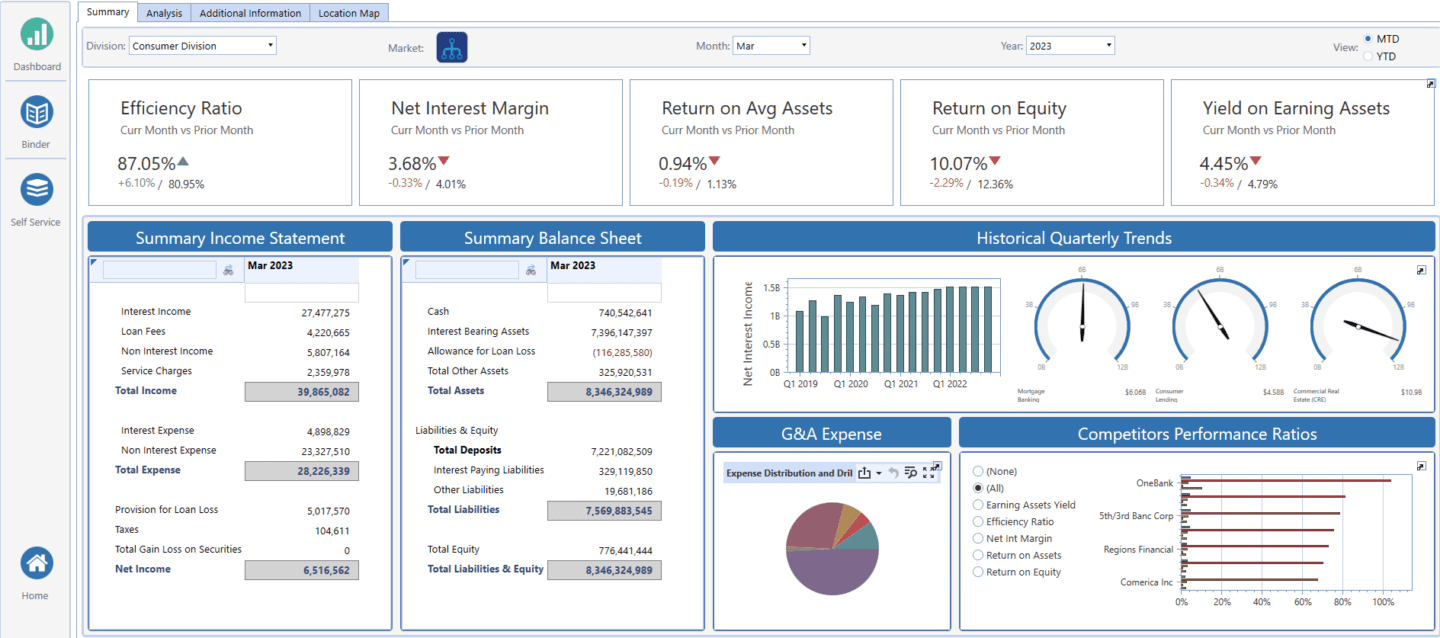The global banking landscape has undergone substantial transformations over the last five decades, marked by shifts in regulations and technological advancements. As the digital age dawned, banking operations evolved. How? Traditional ledger books have been replaced by a realm of heightened complexity and capabilities surrounding bank data management. Much like the changes a century ago during the era of Standard Oil, today’s banking innovations are poised to usher in transformative shifts – with long-term consequences.
Successful banks, as they always have, must adapt to this evolving environment. To do so, banks must understand, harness and leverage data management to gain a competitive edge.
Banks today are facing historic levels of volatility fueled by recent central bank decisions, geopolitical instability and economic insecurity. To remain both competitive and compliant with regulations in this environment, banks must leverage the vast amounts of proprietary data and open-source information available. However, the industry’s complex recordkeeping and multiple data systems make it highly challenging to gain any insights into performance.
What’s needed to change that? To start, banks need a way to streamline data processing to allow for real-time reporting. Banks also need the ability to layer in rapidly updated data from an ever-changing external environment. OneStream Corporate Performance Management (CPM) provides this solution. It allows financial institutions to mobilize bank intelligence and data pools to improve specific tactical and regulatory outcomes.
In a rapidly changing economic and regulatory climate, that kind of agility is the new standard of a high-performing financial institution, regardless of its size. OneStream provides key benefits to financial institutions looking to thrive in this new environment.
Now, let’s explore 5 crucial aspects of OneStream CPM and how it revolutionizes the financial industry.
1. Bringing Finance Teams Bank Data Management with a Single Framework
OneStream brings multiple data sources into a single framework that encompasses the core Finance processes of planning, reporting, and analytics. (See Figure 1) Traditional CPM includes the methods, metrics and systems used to monitor and manage organizational performance. So, how does OneStream offer a new level of value? This unified approach scales and integrates disparate data sources, harnessing machine learning for executive dashboards and more.
For banks, this means translating every business result change into strategic decision-making insights, enhancing collaboration and vision with complete information traceability.

Figure 1: OneStream’s unified platform
Why does that matter so much for banks? Well, banking institutions live by and for the financial results. Finance leaders instinctively understand some key dynamics:
- How each change in a period’s business results impacts regulatory ratios
- How changes in performance will affect the bank’s competitive position compared to peer banks
- How each new piece of information impacts strategy and leadership decisions
Within that context, OneStream removes incompatibilities between systems to drive collaboration, teamwork and vision with complete information traceability.
What if an operational area’s Finance team provided results for a defined reporting period and some proposed, area-specific strategic shifts for the future based on bank KPI trends and external dynamics? An example helps answer that question:
- Scenario: A regional asset management team significantly increasing deposit rates within minutes of a geographic competitor’s earnings call or a press release.
- Key Consideration: The proposed strategic deposit rate shift could impact the bank’s liquidity, efficiency, leverage and net stable funding ratios.
In such scenarios, OneStream puts the right information at decision-makers’ fingertips to empower strategy execution at speeds previously unattainable.
2. Increasing Financial Close Speed
Historically, the financial close process required coordinating a host of disparate systems, spreadsheets, departmental methods and GAAP/IFRS adjustments that, if everything went perfectly, took 10 days.
OneStream CPM instead streamlines closing activities to enable a new operational tempo. This results in account reconciliations, close management, consolidations, and reporting taking less time and resources, allowing for better capital, resource, and talent allocation.
The time saved allows improved capital, resource and talent allocation to give leaders the foresight and flexibility to take advantage of a shifting competitive landscape.
CPM tools combine financial and operational data from independent sources, providing a clear view of institutional performance. Further, direct integration with drill-back ability is built for any open enterprise resource planning (ERP), including Oracle, PeopleSoft, JDE, SAP, Infor and Microsoft AX/Dynamics. This integration enables the quick deployment of solutions from OneStream Cloud, powered by Microsoft Azure.
3. Unlocking New Levels of External Data Utilization and Integration
For financial institutions, fragmented internal systems, databases and processes cause most delays in consolidating information into actionable insights. (See Figure 2)

Figure 2: OneStream Real-time alerts/Financial Signals KPI dashboard
OneStream enables banks to integrate a wide array of external data, offering insights into consumer behavior through artificial intelligence and machine learning. This approach allows for more strategic decision-making, identifying key drivers of change and developing plausible future scenarios. By applying artificial intelligence and machine learning to this data, OneStream identifies patterns that are too difficult to discover manually.
As another example, if yesterday’s analyses could uncover the patterns that identified credit card opportunities based on clientele credit scores, tomorrow’s predictive analyses will identify capital markets activity from search engine metrics and website traffic numbers by the hour. The decision managing directors must make, therefore, shifts away from which common indicators to follow and instead focuses on what outside data is worth investing in. In other words, OneStream’s framework enables the next generation of active strategic decision-making.
The new standard of data utilization in banking ultimately helps identify key drivers of change, develop a range of plausible future scenarios and determine the expected impact of each scenario.
4. Complementing Smart Scenario Analysis, Stress Testing and Talent Allocation
The banking industry is familiar with monumental shifts. For instance, the capital requirements and corresponding reporting necessary after the Basel III Accords dramatically changed how banks are managed. The Basel III Accords built upon the similarly transformational Basel I and Basel II Accords, which emerged in response to the Savings & Loan Crisis in the 1970s and early 1980s.
OneStream facilitates varied scenario evaluations, helping banks identify potential risks and opportunities. This allows banks to prepare for future outcomes based on data about probable scenarios rather than relying solely on historical data.
Today, the various business models in banking must maintain regulatory capital demands, with “well-capitalized” defined as a level above the minimum. OneStream helps do just that thanks to its overarching goal of enabling varied scenario evaluations: identifying potential risks and opportunities. That information then allows banks to prepare for the future using data about probable outcomes rather than being forced to react to events based on historical data.
OneStream brings all of the data management required for scenario evaluations and modeling.
5. Offensively Utilizing Market Dynamics for Differentiation
With OneStream, banks can navigate reduced complexity to gain a competitive advantage. OneStream CPM brings data fluency to the boardroom, empowering executives with amplified information and enabling swift responses to market changes. Forces beyond the bank – whether supply chain disruptions, inflation, Environmental, Social and governance (ESG) changes or technological advancement – will only continue to complicate the challenges presented to decision-makers. With OneStream CPM, however, banks can bring data fluency to the boardroom via an intuitive user experience, putting the power of amplified information into executives’ hands.
Institutions that implement a new level of data management can achieve the following to remain agile in today’s ever-changing environment:
- Speed up financial planning and analysis
- Reallocate resources and capital
- Take advantage of the intricacy now burdening less sophisticated participants
These swift, committed responses to changing dynamics ultimately maximize strategic differentiation.
In customer-facing roles on the front line, teammates will have access to new levels of data and intelligence that bring value to their clients. Banks will then gain a bigger reputation as a valued partner. For banks investing in data management, teamwork and communication will connect mission-level strategy to street-level results.
Conclusion
In conclusion, OneStream CPM equips banks with the tools needed to continuously update intelligence and adapt in an evolving environment. It serves as a force multiplier for operational expertise, helping to capture market share and grow institutional value.
To learn more about how OneStream CPM can empower your institution with data-powered banking solutions, visit our previous data management article.
Get Started With a Personal Demo



